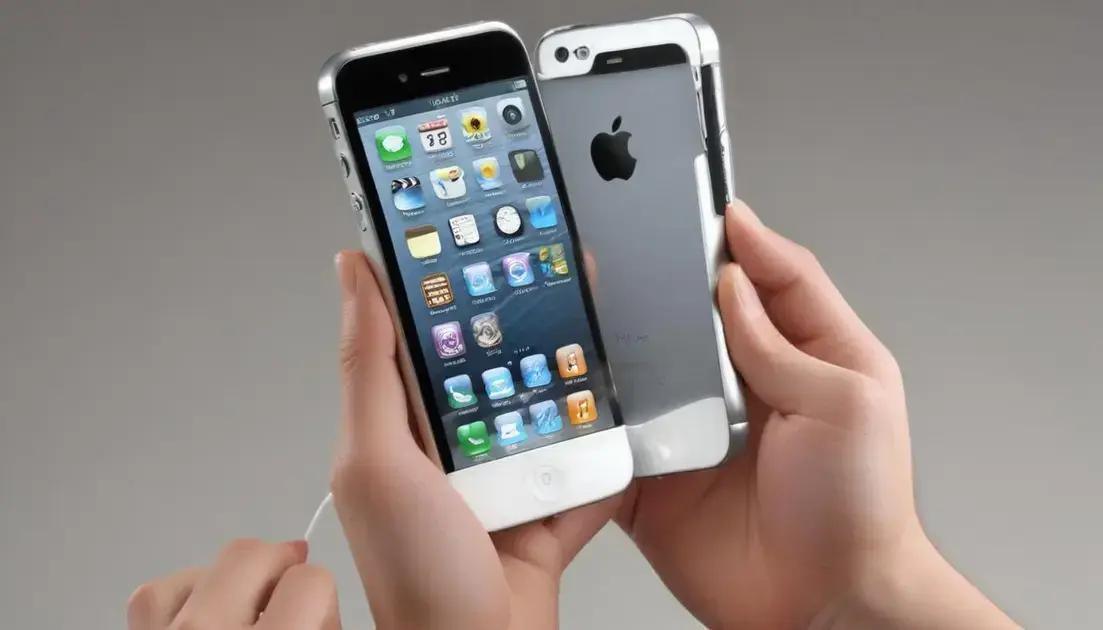
How the iPhone Revolutionized Technology and Changed the World in 2007
The iPhone revolutionized technology and communication when it launched in 2007, combining a phone, iPod, and internet communicator into one device. Its features, like the multi-touch screen and App Store, changed how people interact with smartphones and created new opportunities for app developers. The iPhone’s influence extends beyond technology, altering daily social interactions and emphasizing connectivity, making it an essential tool in modern life.
iPhone: a device that changed everything. On January 9, 2007, we witnessed not just a phone, but a revolution in technology that would redefine our daily interactions. Curious about its lasting impact?
Introduction to the iPhone’s Launch
The launch of the iPhone was a game changer. On January 9, 2007, Steve Jobs introduced this groundbreaking device at a special event. It wasn’t just a phone; it combined a phone, an iPod, and a web browser all in one. People were amazed at its sleek design and touch interface.
Before the iPhone, smartphones were complicated and hard to use. The iPhone made it easy and fun. Its multi-touch screen let users swipe, pinch, and tap with ease. This feature changed how we interact with our devices forever.
The excitement around the iPhone launch was huge. Fans camped outside the Apple stores to be the first ones to own it. The demand was immense and it quickly became a cultural icon.
With the iPhone, Apple didn’t just sell a product; they created a new way for people to connect. The device brought the internet into our hands, making it more accessible than ever. It opened doors to countless applications that changed how we communicate, work, and live.
In just a short time, the iPhone shaped the tech landscape. Its launch marked the beginning of a new era in mobile technology. Everyone wanted one, and soon, smartphones became a part of everyday life.
The Features That Redefined Smartphones
The iPhone came packed with features that changed the game for smartphones. One of its most exciting features was the multi-touch screen. This allowed users to swipe, pinch, and tap, making navigation super smooth.
Another big hit was the App Store. It opened up a world of apps that let users customize their phones. From games to productivity tools, the options were endless. This shift made smartphones not just devices for calls, but tools for everything.
The camera on the iPhone was also a standout. It allowed people to take high-quality photos easily. With features like autofocus and image stabilization, anyone could capture great moments without needing a fancy camera.
The sleek design and user-friendly interface made it appealing too. People loved the minimalist look and simple icons. It was fresh and modern, setting a new standard for mobile design.
All these features combined made the iPhone more than just a phone. It turned into a lifestyle device that connected people in new ways. Thanks to the iPhone, smartphones became part of our daily lives, shaping how we communicate, work, and entertain ourselves.
The Impact on App Development
The launch of the iPhone had a huge impact on app development. It changed how developers think about creating software. The introduction of the App Store allowed developers to reach millions of users easily.
Before the iPhone, apps were mostly made for specific devices, limiting their reach. With the iPhone, apps could be created for a broader audience. This opened the door for new ideas and innovations.
Developers quickly realized they could create apps for everyday needs. From games to navigation tools, the possibilities were endless. This surge in creativity led to a wide variety of options for users.
The iPhone’s easy-to-use interface made it simple for anyone to use apps. As more people adopted smartphones, the demand for quality apps grew. Developers needed to focus on usability and design to keep users engaged.
This shift also encouraged developers to collaborate and share ideas. Communities formed around app development, helping each other learn and grow. It fostered an environment of rapid innovation that continues today.
Overall, the iPhone transformed the app development landscape. It created opportunities for countless developers and changed how we use technology daily.
How the iPhone Changed Communication
The iPhone changed communication in ways we never expected. It brought people closer together through its innovative features. With the iPhone, making a call became just the start of connecting.
Text messaging transformed too. The introduction of iMessage allowed users to send messages quickly, using Wi-Fi or data. This was faster and cheaper than traditional texting. It also included fun features like stickers and animated GIFs.
Video calling became mainstream with FaceTime. People could see each other while talking, no matter the distance. This feature made it easier for friends and family to stay connected.
The iPhone also integrated social media apps. It made sharing updates with friends easy and immediate. Users could post photos, check-in at locations, or see what others were doing in real-time.
Moreover, communication wasn’t limited to just talking anymore. With various apps, users could send voice notes, share locations, and even have group chats. All these tools made interactions richer and more dynamic.
In many ways, the iPhone redefined how we communicate daily. It shifted from simple texts or calls to a multi-faceted approach. Today, our conversations are more engaging thanks to the iPhone.
The Legacy of the iPhone
The iPhone left a lasting legacy on technology and culture. It wasn’t just a phone; it was a revolutionary device that changed how we live. Its impact can be seen everywhere today.
First, the iPhone changed the smartphone industry forever. Other companies had to rethink how they design and sell their phones. Features like a touchscreen and an app ecosystem became standard after the iPhone’s launch.
The app development boom is another part of its legacy. Many people made careers creating apps for the iPhone. This transformed the way businesses operate, as apps became essential tools for growth.
Moreover, the iPhone influenced social interactions. It changed how we communicate and share our lives. With smartphones in our pockets, staying connected is easier than ever.
In education and business, the iPhone also played a role. It made information accessible wherever you are. People can learn, work, and communicate instantly. This shift has created a more informed society.
Finally, the iPhone built a loyal community. Apple’s brand and design philosophy attracted millions of fans. These customers are often passionate about the latest updates and features.
Overall, the iPhone’s legacy continues to shape our world. Its influence extends beyond technology, impacting our culture and daily lives.
Conclusion
In conclusion, the iPhone has dramatically changed the way we live and communicate. Its influence reaches far beyond just being a phone. From redefining what smartphones can do to sparking a whole new world of app development, the iPhone has set a standard that others strive to follow.
Moreover, it has shaped our daily interactions and made staying connected easier than ever. The iPhone’s impact on education, business, and social life shows how powerful technology can be.
Ultimately, the legacy of the iPhone is not just in its features, but in how it transformed our culture. As we continue to embrace new technology, the lessons from the iPhone’s success will inspire future innovations. Recognizing its impact can help us appreciate how much it has enhanced our lives.


